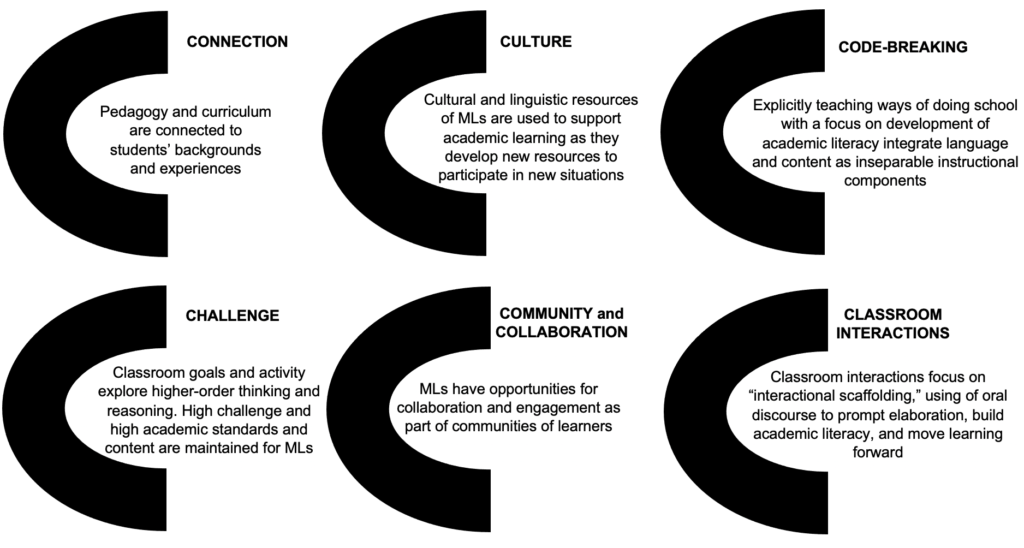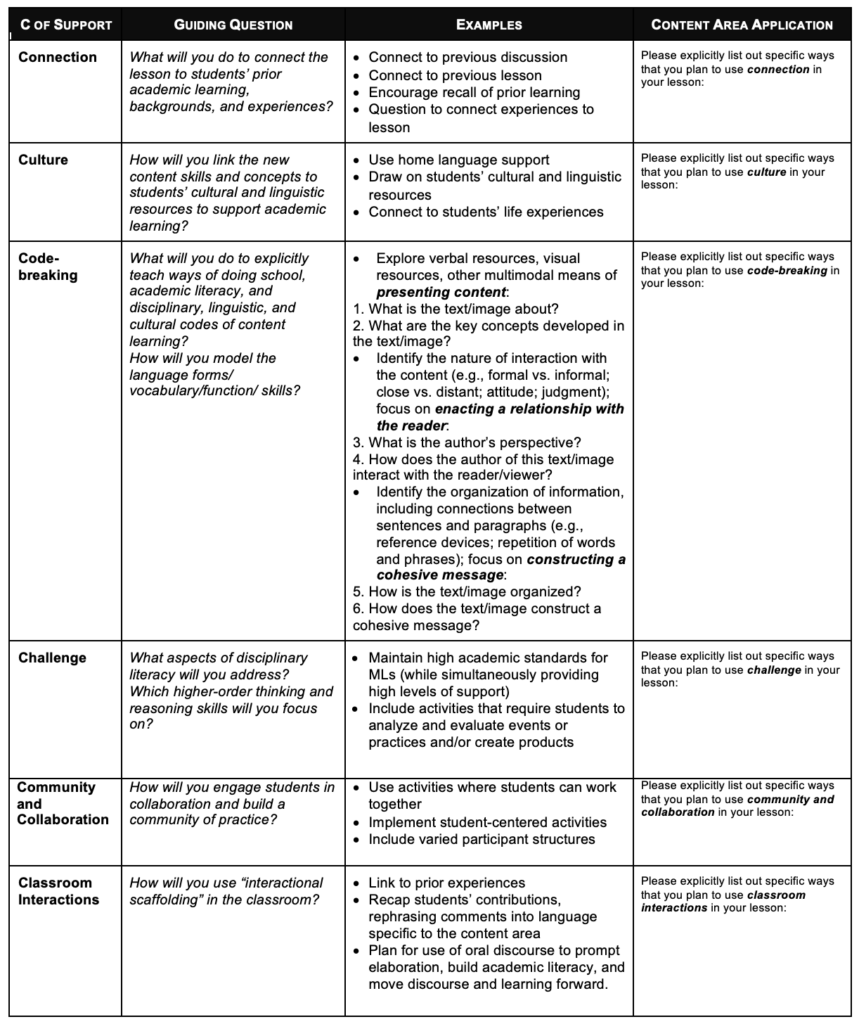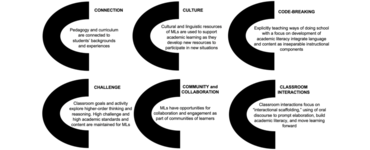A language-based approach to content instruction (LACI) provides a framework for addressing content and language needs of multilingual learners by focusing on six Cs of support for scaffolding.
Key words: language-based approach to content instruction, English language learners, bilingual students, scaffolding, multilingual classrooms, general education classrooms
Increasing numbers of multilingual learners (MLs) in schools have led teachers to search for approaches to help them reach this student population. One such approach is entitled a language-based approach to content instruction (LACI; de Oliveira, 2016, 2017). LACI places emphasis on language learning in the content area classroom, helping teachers foreground the language as a way into the content. Teachers, therefore, address both language and content simultaneously, as these are inseparable components. LACI, with a focus on content through language rather than on language through content, can be a means through which instruction for multilingual learners (MLs) can be accomplished in meaningful ways in a general education content area classroom.
LACI provides MLs with access to the language of the different content areas, not by simplifying content but by enabling MLs to manipulate language as it is written, without simplification. The notion of making content accessible is taken here to mean providing access to the academic language that constructs content knowledge. This approach is a powerful tool for raising teachers’ awareness about the challenges of learning content, and enables them to more effectively contribute to the language development of MLs. The goal is to provide teachers with ways of talking about the language that enable them to focus on content and language.
This article describes LACI’s six Cs of support for scaffolding content and language instruction for MLs (see Figure 1). It presents a lesson plan template for planning instruction for MLs and a guide for teachers to address the six Cs of support and structure content area instruction for MLs.

LACI’s six Cs of support
LACI builds on six Cs of support to provide scaffolding that have identified specific elements of instructional activities for MLs, as presented in Figure 1. The C of connection refers to the ways in which teachers can connect pedagogy and curriculum to students’ backgrounds and experiences (Ladson-Billings, 2014; Lucas & Villegas, 2011; Paris, 2012; Paris & Alim, 2012). The C of culture as a principle enables students to build on prior knowledge by accessing cultural and linguistic resources (Moll et al., 1992; Valenzuela, 1999). Students’ cultural and linguistic resources, or their “funds of knowledge” from home communities (Moll et al, 1992), are used to support academic learning as MLs develop new resources to be able to participate in new situations, bridging home and school and enhancing opportunities for students to learn (Valenzuela, 1999).
Code-breaking involves explicitly teaching ways of doing school, academic literacy, and disciplinary, linguistic, and cultural codes of content learning (Fang, 2006; Moore & Schleppegrell, 2014; Schleppegrell, 2001, 2004). It is through this C of support that we see a clear integration of language and content as inseparable instructional components. The focus on academic literacy as a process of making academic dimensions of subject matter transparent for MLs includes bridging everyday and academic language as essential for understanding of content (Gibbons, 2006). Code-breaking uses principles of a meaning-based theory of language, systemic-functional linguistics (SFL) (Halliday & Matthiessen, 2004). This theory does not separately address language and content, but instead sees language as the realization of meaning in context. From this perspective, we place emphasis on content, helping teachers understand how the language works to construct knowledge in the discipline. LACI, and specifically code-breaking, enables a focus on language from each of these three angles: presenting ideas, enacting a relationship with the reader or listener, and constructing a cohesive message (de Oliveira & Schleppegrell, 2015). In terms of presenting ideas, we focus on the content of the message, looking at verbal and visual resources that construct the content presented in the nouns, verbs, prepositional phrases, and adverbs. Enacting a relationship with the reader or listener enables us to identify language resources that indicate the kind of relationship we are enacting; whether it is formal or informal, close or distant, and whether it includes attitudes of various kinds. We can explore the verbal and visual resources that construct the nature of relationships among speakers/listeners, writers/readers, and viewers, and what is viewed. Constructing a cohesive message involves language choices that construct a message that holds together. We explore the verbal and visual resources that are concerned with the organization of the information and elements of texts and images used to present content in a cohesive way.
Challenge relates to classroom goals and activities that explore disciplinary literacy and higher-order thinking and reasoning. High challenge and high academic standards and content are maintained for MLs (Hammond, 2006). The C of community and collaboration refers to joint productive activity in which students co-construct knowledge (Brown & Campione, 1994; Lave & Wenger, 1991). Teachers create communities of learners where all students participate in activities to socially construct knowledge (Nieto, 2000).
Classroom interactions focus on “interactional scaffolding,” the use of oral discourse to prompt elaboration, build academic literacy, and move discourse and learning forward (de Oliveira & Smith, 2019; de Oliveira et al., 2020; Hammond & Gibbons, 2005). Interactional scaffolding includes three main processes:
- Linking to prior experience, pointing to new experiences, and recapping refers to teachers’ ability to target a specific learning area to MLs’ current levels of knowledge and their English language abilities.
- Appropriating and recasting students’ contributions, typically during discussions or elicitations, involves the teacher’s direction of students’ contributions by means of recasting their words into more content, language, context appropriate discourse.
- Using the Initiation, Response, Feedback (IRF) sequence includes teachers offering strong verbal or gestural hints about expected responses, especially targeting specific students for specific purposes so students can say more and reflect on their understanding, that is, they ask for clarifications, probe a student’s response, or ask to explain a particular point in detail.
LACI application framework for content area teaching
LACI has been applied in pre-service and in-service teacher education to focus on the teaching of all content areas—English language arts, mathematics, science, and social studies. For this article, I show the lesson plan format used for LACI planning and a planning guide with LACI’s 6 Cs of support.

Lesson plan
The lesson plan format that evolved from the implementation of LACI over the years is presented next. This lesson plan format includes the principles of the six Cs of support along with the more “traditional” elements of a lesson plan, including:
- content and English language development standards
- content and language objectives
- instructional strategies and learning tasks through which teachers plan the delivery of the lesson and how they will differentiate for different groups of students
Planning guide utilizing the six Cs of support for content instruction of multilingual learners
The planning guide shown after the lesson plan (Table 1) presents questions, examples, and a column for teachers to plan how they would address the six Cs of support and structure content area instruction for MLs. Teachers can use this guide as they are using the lesson plan template.
Conclusion
This article presented LACI’s six Cs of support for scaffolding, a lesson plan template using these Cs, and a guide to help teachers plan instruction for MLs. Content area teachers need knowledge and practical ideas about addressing the academic language needs of MLs since they have the dual responsibility of facilitating MLs’ content learning while also supporting their ongoing English language development. LACI accomplishes this dual focus by helping teachers develop ways to talk about both language and content. The six Cs of support integrated in LACI provide the kind of access that is crucial for MLs who are learning content and language and simultaneously.
References
Brown, A. L., & Campione, J. C. (1994). Guided discovery in a community of learners. In K. McGilly (Ed.) Classroom lessons: Integrating cognitive theory and classroom practice (pp. 229-270). MIT Press.
de Oliveira, L. C. (2016). A language-based approach to content instruction (LACI) for English language learners: Examples from two elementary teachers. International Multilingual Research Journal, 10(3), 217-231. https://doi.org/10.1080/19313152.2016.1185911
de Oliveira, L. C. (2017). A language-based approach to content instruction (LACI) in science for English language learners. In A. Oliveira & M. Weinburgh (Eds), Science teacher preparation in content-based second language acquisition (pp. 41-58). Association of Science Teacher Education and Springer.
de Oliveira, L. C., Jones, L., & Smith, S. L. (2020). Interactional scaffolding in a first-grade classroom through the teaching/learning cycle. International Journal of Bilingual Education and Bilingualism. https://doi.org/10.1080/13670050.2020.1798867
de Oliveira, L. C., & Schleppegrell, M. J. (2015). Focus on grammar and meaning. Oxford University Press.
de Oliveira, L. C., & Smith, S. L. (2019). Interactions with and around texts: Writing in elementary schools. In N. Caplan, & A. Johns (Eds.), Changing practices for the L2 writing classroom: Moving beyond the five-paragraph essay (pp. 65-88). University of Michigan Press.
Fang, Z. (2006). The language demands of science reading in middle school. International Journal of Science Education, 28(5), 491-520. https://doi.org/10.1080/09500690500339092
Gibbons, P. (2006). Bridging discourses in the ESL classroom: Students, teachers and researchers. Continuum.
Halliday, M. A. K., & Matthiessen, C.M. (2004). An introduction to functional grammar (3rd ed). Arnold.
Hammond, J. & Gibbons, P. (2005). Putting scaffolding to work: The contribution of scaffolding in articulating ESL education. Prospect, 20(1), 6-30 http://hdl.handle.net/1959.14/329484
Hammond, J. (2006). High challenge, high support: Integrating language and content instruction for diverse learners in an English literature classroom. Journal of English for Academic Purposes, 5, 269-283. https://doi.org/10.1016/j.jeap.2006.08.006
Ladson-Billings, G. (2014). Culturally relevant pedagogy 2.0: A.k.a. the remix. Harvard Educational Review, 84(1), 74-84. https://doi.org/10.17763/haer.84.1.p2rj131485484751
Lave, J. & Wenger, E. (1991). Situated learning: Legitimate peripheral participation. Cambridge University Press.
Lucas, T., & Villegas, A. M. (2011). A framework for preparing linguistically responsive teachers. In T. Lucas (Ed.), Teacher preparation for linguistically diverse classrooms: A resource for teacher educators (pp. 55–72). Routledge.
Moll, L., Amanti, C., Neff, D. & Gonzalez, N. (1992). Funds of knowledge for teaching: Using a qualitative approach to connect homes and classrooms. Theory into Practice, 31(2), 132-141. https://doi.org/10.1080/00405849209543534
Moore, J., & Schleppegrell, M. J. (2014). Using a functional linguistics metalanguage to support academic language development in the English Language Arts. Linguistics and Education 26, 92-105. https://doi.org/10.1016/J.LINGED.2014.01.002
Nieto, S. (2000). Affirming diversity: The sociopolitical context of multicultural education (3rd ed.). Longman.
Paris, D. (2012). Culturally sustaining pedagogy: A needed change in stance, terminology, and practice. Educational Researcher, 41(3), 93-97. https://doi.org/10.3102%2F0013189X12441244
Paris, D., & Alim, H. S. (2012). Culturally sustaining pedagogies: Teaching and learning for justice in a changing world. Teachers College Press.
Schleppegrell, M. J. (2001). Linguistic features of the language of schooling. Linguistics and Education, 12(4), 431-459. https://psycnet.apa.org/doi/10.1016/S0898-5898(01)00073-0
Schleppegrell, M. J. (2004). The language of schooling: A functional linguistics perspective. Erlbaum.
Valenzuela, A. (1999). Subtractive schooling: U.S.-Mexican youth and the politics of caring. SUNY Press.









